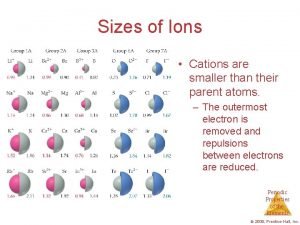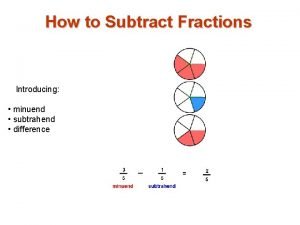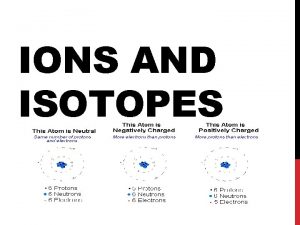Sizes of Ions Cations are smaller than their










- Slides: 10

Sizes of Ions • Cations are smaller than their parent atoms. – The outermost electron is removed and repulsions between electrons are reduced. Periodic Properties of the Elements © 2009, Prentice-Hall, Inc.

Sizes of Ions • Anions are larger than their parent atoms. – Electrons are added and repulsions between electrons are increased. Periodic Properties of the Elements © 2009, Prentice-Hall, Inc.

Sizes of Ions • Ions increase in size as you go down a column. – This is due to increasing value of n. Periodic Properties of the Elements © 2009, Prentice-Hall, Inc.

Sizes of Ions • In an isoelectronic series, ions have the same number of electrons. • Ionic size decreases with an increasing nuclear charge. Periodic Properties of the Elements © 2009, Prentice-Hall, Inc.

Ionization Energy • The ionization energy is the amount of energy required to remove an electron from the ground state of a gaseous atom or ion. – The first ionization energy is that energy required to remove first electron. – The second ionization energy is that energy required to remove second electron, etc. Periodic Properties of the Elements © 2009, Prentice-Hall, Inc.

Ionization Energy • It requires more energy to remove each successive electron. • When all valence electrons have been removed, the ionization energy takes a quantum leap. Periodic Properties of the Elements © 2009, Prentice-Hall, Inc.

Trends in First Ionization Energies • As one goes down a column, less energy is required to remove the first electron. – For atoms in the same group, Zeff is essentially the same, but the valence electrons are farther from the nucleus. Periodic Properties of the Elements © 2009, Prentice-Hall, Inc.

Trends in First Ionization Energies • Generally, as one goes across a row, it gets harder to remove an electron. – As you go from left to right, Zeff increases. Periodic Properties of the Elements © 2009, Prentice-Hall, Inc.

Trends in First Ionization Energies However, there are two apparent discontinuities in this trend. Periodic Properties of the Elements © 2009, Prentice-Hall, Inc.

Trends in First Ionization Energies • The first occurs between Groups IIA and IIIA. • In this case the electron is removed from a p-orbital rather than an s-orbital. – The electron removed is farther from nucleus. – There is also a small amount of repulsion by the s electrons. Periodic Properties of the Elements © 2009, Prentice-Hall, Inc.
 Sizes of ions
Sizes of ions Men's shirt sizes are determined by their neck sizes
Men's shirt sizes are determined by their neck sizes Antigentest åre
Antigentest åre Positive ions and negative ions table
Positive ions and negative ions table Is a mouse big or small
Is a mouse big or small What is a minuend
What is a minuend What is smaller than an atom
What is smaller than an atom Periodic table monatomic ions
Periodic table monatomic ions Paper chromatography separation of cations and dyes
Paper chromatography separation of cations and dyes Cations and anions table
Cations and anions table Cathode vs anode equation
Cathode vs anode equation



















